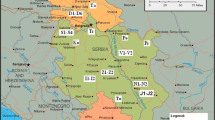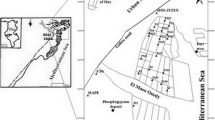Abstract
Purpose
Sequential extraction procedure (SEP) verifies which of the bioavailable extraction phases has the greatest potential for releasing metals from a given set of samples. The hypothesis here is that it is possible to find a correlation between the presence of metals in different bioavailable chemical fractions (data obtained by SEP) and results of ecotoxicological tests conducted with Hyalella azteca, under controlled laboratory conditions in field-collected sediment samples.
Methods
Sediment samples from an urban lake were submitted to SEP to analyze the fractionation of heavy metals (Cd, Cr, Cu, Ni, Pb and Zn) in bioavailable and non-bioavailable extraction phases. Spearman correlation, Mann–Whitney U test, hierarchical cluster analysis (HCA), and principal component analysis (PCA) assessed the influence of heavy metals on the survival of the test organism.
Results and discussions
Copper and Cr, mainly bound to the oxidizable phase, were the metals that were most closely related to the mortality of H. azteca (PC1). Zinc bound to the oxidizable phase and Pb also showed an association with the mortality of the test organism, but with less representation (PC2). Cadmium and Ni were the metals less correlated with the low survival of H. azteca.
Conclusion
The results indicate that the bioavailable chemical fractions may reflect the interactive effect of metals in mixtures on the survival of the test organism.





Similar content being viewed by others
Data availability
The data used to support the results of this research can be obtained from the corresponding author upon request.
Code availability
Not applicable.
References
ABNT NBR 13373 (2017) Ecotoxicologia aquática — Toxicidade crônica — Método de ensaio com Ceriodaphnia spp (Crustacea, Cladocera)
Ahn JM, Kim S, Kim YS (2020) Selection of priority management of rivers by assessing heavy metal pollution and ecological risk of surface sediments. Environ Geochem Health 42:1657–1669. https://doi.org/10.1007/s10653-019-00284-9
Amini A, Qishlaqi A (2020) Spatial distribution, fractionation and ecological risk assessment of potentially toxic metals in bottom sediments of the Zarivar freshwater Lake (Northwestern Iran). Limnologica 84:125814. https://doi.org/10.1016/j.limno.2020.125814
Araújo RPA, Botta-Paschoal CMR, Silvério PF et al (2006) Application of toxicity identification evaluation to sediment in a highly contaminated water reservoir in southeastern Brazil. Environ Toxicol Chem 25:581. https://doi.org/10.1897/05-144R.1
Baran A, Tarnawski M (2015) Assessment of heavy metals mobility and toxicity in contaminated sediments by sequential extraction and a battery of bioassays. Ecotoxicology 24:1279–1293. https://doi.org/10.1007/s10646-015-1499-4
Barbosa JS, Cabral TM, Ferreira DN et al (2010) Genotoxicity assessment in aquatic environment impacted by the presence of heavy metals. Ecotoxicol Environ Saf 73:320–325. https://doi.org/10.1016/j.ecoenv.2009.10.008
Borgmann U, Couillard Y, Doyle P, Dixon DG (2005) Toxicity of sixty-three metals and metalloids to Hyalella azteca at two levels of water hardness. Environ Toxicol Chem 24(3):641. https://doi.org/10.1897/04-177R.1
Boughriet A, Proix N, Billon G et al (2007) Environmental impacts of heavy metal discharges from a smelter in Deûle-canal sediments (northern France): Concentration levels and chemical fractionation. Water Air Soil Pollut 180:83–95. https://doi.org/10.1007/s11270-006-9252-5
Buch AC, Brown GG, Correia MEF et al (2017) Ecotoxicology of mercury in tropical forest soils: impact on earthworms. Sci Total Environ 589:222–231. https://doi.org/10.1016/j.scitotenv.2017.02.150
Cao L, Tian H, Yang J et al (2015) Multivariate analyses and evaluation of heavy metals by chemometric BCR sequential extraction method in surface sediments from Lingdingyang Bay, South China. Sustain 7:4938–4951. https://doi.org/10.3390/su7054938
de Menezes Oliveira VB, de Oliveira BM, Espíndola ELG (2018) Hazard assessment of the pesticides KRAFT 36 EC and SCORE in a tropical natural soil using an ecotoxicological test battery. Environ Toxicol Chem 37:2919–2924. https://doi.org/10.1002/etc.4056
de Passos E, A, Alves JC, dos Santos IS et al (2010) Assessment of trace metals contamination in estuarine sediments using a sequential extraction technique and principal component analysis. Microchem J 96:50–57. https://doi.org/10.1016/j.microc.2010.01.018
Hoffman DJ, Rattner BA, Allen G, Burton JCJ Jr (2003) Handbook of Ecotoxicology, 2nd edn. Lewis Publishers
Hall GEM, Gauthier G, Pelchat JC et al (1996) Application of a sequential extraction scheme to ten geological certified reference materials for the determination of 20 elements. J Anal at Spectrom 11:787–796. https://doi.org/10.1039/ja9961100787
Hennebert P (2018) Proposal of concentration limits for determining the hazard property HP 14 for waste using ecotoxicological tests. Waste Manag 74:74–85. https://doi.org/10.1016/j.wasman.2017.11.048
Hou D, He J, Lü C et al (2013) Distribution characteristics and potential ecological risk assessment of heavy metals (Cu, Pb, Zn, Cd) in water and sediments from Lake Dalinouer, China. Ecotoxicol Environ Saf 93:135–144. https://doi.org/10.1016/j.ecoenv.2013.03.012
Huggett DB, Schlenk D, Griffin BR (2001) Toxicity of copper in an oxic stream sediment receiving aquaculture effluent. Chemosphere 44:361–367. https://doi.org/10.1016/s0045-6535(00)00354-4
Jones RP, Hassan SM, Rodgers JH (2008) Influence of contact duration on sediment-associated copper fractionation and bioavailability. Ecotoxicol Environ Saf 71:104–116. https://doi.org/10.1016/j.ecoenv.2007.09.004
Kalwa M, Quináia SP, Pletsch AL et al (2013) Fractionation and potential toxic risk of metals from superficial sediment in Itaipu Lake-boundary between Brazil and Paraguay. Arch Environ Contam Toxicol 64:12–22. https://doi.org/10.1007/s00244-012-9811-2
Kartal Ş, Aydin Z, Tokalioǧlu Ş (2006) Fractionation of metals in street sediment samples by using the BCR sequential extraction procedure and multivariate statistical elucidation of the data. J Hazard Mater 132:80–89. https://doi.org/10.1016/j.jhazmat.2005.11.091
Kennou B, El Meray M, Romane A, Arjouni Y (2015) Assessment of heavy metal availability (Pb, Cu, Cr, Cd, Zn) and speciation in contaminated soils and sediment of discharge by sequential extraction. Environ Earth Sci 74:5849–5858. https://doi.org/10.1007/s12665-015-4609-y
Kwon S, Thomas J, Reed BE et al (2010) Evaluation of sorbent amendments for in situ remediation of metal-contaminated sediments. Environ Toxicol Chem 29:1883–1892. https://doi.org/10.1002/etc.249
Landis W, Sofield R, Yu MH, Wayne G (2004) Introduction to environmental toxicology: impacts of chemicals upon ecological systems, 3rd edn. Lewis Publishers
Lee S, An J, Kim YJ, Nam K (2011) Binding strength-associated toxicity reduction by birnessite and hydroxyapatite in Pb and Cd contaminated sediments. J Hazard Mater 186:2117–2122. https://doi.org/10.1016/j.jhazmat.2010.12.126
Maccari AP, Baretta D, Paiano D et al (2016) Ecotoxicological effects of pig manure on Folsomia candida in subtropical Brazilian soils. J Hazard Mater 314:113–120. https://doi.org/10.1016/j.jhazmat.2016.04.013
Melo JG, Vasconcelos MB, Morais SDO, Alves RS (2012) Avaliação hidrogeológica da zona norte da cidade de Natal e os problemas associados ao desenvolvimento urbano. Rev Bras Recur Hídricos 17:123–134. https://doi.org/10.21168/rbrh.v17n1.p123-134
Naji A, Ismail A, Ismail AR (2010) Chemical speciation and contamination assessment of Zn and Cd by sequential extraction in surface sediment of Klang River, Malaysia. Microchem J 95:285–292. https://doi.org/10.1016/j.microc.2009.12.015
Niemeyer JC, Chelinho S, Sousa JP (2017) Soil ecotoxicology in Latin America: current research and perspectives. Environ Toxicol Chem 36:1795–1810. https://doi.org/10.1002/etc.3792
Nobrega TF, Souza RF, Medeiros GF (2017) Ecotoxicological evaluation of water and sediment of an urban and coastal water reservoir in northeastern Brazil. Ambiência 13:393–411. https://doi.org/10.5935/ambiencia.2017.02.09
Nobrega TF, Souza RF, Medeiros GF (2019) Efeito da precipitação e ocupação do solo sobre a qualidade da água superficial de reservatório urbano no litoral do nordeste brasileiro. Rev Gestão Sustentabilidade Ambient 8:626. https://doi.org/10.19177/rgsa.v8e22019626-647
Nobrega TF, Souza RF, Medeiros GF (2020) Ecotoxicological monitoring of urban reservoir sediment located in the coastal region of northeastern Brazil. Ciência e Nat 42:e96. https://doi.org/10.5902/2179460X42329
Norwood WP, Borgmann U, Dixon DG (2007) Interactive effects of metals in mixtures on bioaccumulation in the amphipod Hyalella azteca. Aquat Toxicol 84(2):255–267. https://doi.org/10.1016/j.aquatox.2007.02.023
Rao CRM, Sahuquillo A, Lopez Sanchez JF (2008) A review of the different methods applied in environmental geochemistry for single and sequential extraction of trace elements in soils and related materials. Water Air Soil Pollut 189:291–333
Rauret G, López-Sánchez JF, Sahuquillo A et al (1999) Improvement of the BCR three step sequential extraction procedure prior to the certification of new sediment and soil reference materials. J Environ Monit 1:57–61. https://doi.org/10.1039/a807854h
Relić D, Dordević D, Popović A, Blagojević T (2005) Speciations of trace metals in the Danube alluvial sediments within an oil refinery. Environ Int 31:661–669. https://doi.org/10.1016/j.envint.2004.11.003
Rinklebe J, Shaheen SM (2014) Assessing the mobilization of cadmium, lead, and nickel using a seven-step sequential extraction technique in contaminated floodplain soil profiles along the Central Elbe River, Germany. Water Air Soil Pollut 225:1–20. https://doi.org/10.1007/s11270-014-2039-1
Sakan S, Gržetić I, Đorđević D (2007) Subject Area 1.2: Monitoring of chemicals in soils/sediments distribution and fractionation of heavy metals in the Tisa (Tisza) River sediments. Env Sci Pollut Res 14:229–236
Sindern S, Lima RFS, Schwarzbauer J, Petta RA (2007) Anthropogenic heavy metal signatures for the fast growing urban area of Natal (NE-Brazil). Environ Geol 52:731–737. https://doi.org/10.1007/s00254-006-0510-z
Thomas RP, Ure AM, Davidson CM et al (1994) Three-stage sequential extraction procedure for the determination of metals in river sediments. Anal Chim Acta 286:423–429. https://doi.org/10.1016/0003-2670(94)85088-7
Tokalioǧlu Ş, Kartal Ş, Elçi L (2000) Determination of heavy metals and their speciation in lake sediments by flame atomic absorption spectrometry after a four-stage sequential extraction procedure. Anal Chim Acta 413:33–40. https://doi.org/10.1016/S0003-2670(00)00726-1
Yang J, Chen L, Liu LZ et al (2014) Comprehensive risk assessment of heavy metals in lake sediment from public parks in Shanghai. Ecotoxicol Environ Saf 102:129–135. https://doi.org/10.1016/j.ecoenv.2014.01.010
Acknowledgements
Financial support by Coordination for the Improvement of Higher Education Personnel (CAPES) to W.P.S., V.N.S. and T.F.N. through graduate scholarships is acknowledged. This work was also conducted with funding from National Council for Scientific and Technological Development (CNPq) through a research productivity scholarship to R.F.S., process 311221/2015-7. We would also like to thank all the people who contributed and may come to contribute with edifying discussions towards the completion of this work.
Funding
Funding by Coordination for the Improvement of Higher Education Personnel (CAPES) and National Council for Scientific and Technological Development (CNPq).
Author information
Authors and Affiliations
Contributions
The manuscript is approved by all the authors for publication.
Corresponding author
Ethics declarations
Conflict of interest
The authors declare no competing interests.
Additional information
Responsible editor: Klara Hilscherova
Publisher's Note
Springer Nature remains neutral with regard to jurisdictional claims in published maps and institutional affiliations.
Supplementary information
Below is the link to the electronic supplementary material.
Rights and permissions
About this article
Cite this article
dos Santos, W.P., de Souza, R.F., da Silva, V.N. et al. Use of sequential extraction procedure to support ecotoxicological analyses in bottom sediments of a tropical urban reservoir. J Soils Sediments 22, 1572–1584 (2022). https://doi.org/10.1007/s11368-022-03177-0
Received:
Accepted:
Published:
Issue Date:
DOI: https://doi.org/10.1007/s11368-022-03177-0




